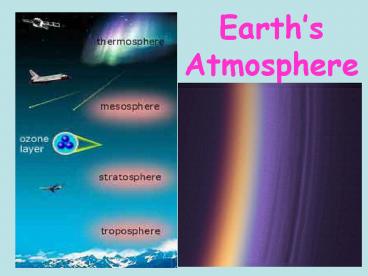Earth - PowerPoint PPT Presentation
1 / 19
Title:
Earth
Description:
Today s atmosphere Layers of the Atmosphere Basis for Layers Layers are based on TEMPERATURE CHANGE within the layer. As you move up through the troposphere, ... – PowerPoint PPT presentation
Number of Views:146
Avg rating:3.0/5.0
Title: Earth
1
Earths Atmosphere
2
How our atmosphere evolved
- I. The early atmosphere did not support life. It
contained deadly gases such as Methane and
Ammonia. There was very little Oxygen. - II. Over time, gases were added to the atmosphere
by volcanic eruptions, and as a result of
chemical reactions due to sunlight.
3
How our atmosphere evolved cont.
- III. The OZONE LAYER formed as a result of the
chemical reactions. Ozone is made of three
oxygen atoms bonded together. It blocks out
ultraviolet radiation from the sun. - IV. The formation of the ozone layer allowed
MICRO-ORGANISMS such as Blue-Green Algae to
appear on earth. They take in carbon dioxide and
release oxygen, so the amount of OXYGEN in the
atmosphere steadily increased.
4
How our atmosphere evolved continued
- V. Stromatolites were some of the early organisms
that used Photosynthesis to convert CO2 into
Oxygen. They still exist today and have survived
5 mass extinctions!
5
Todays atmosphere
6
Layers of the Atmosphere
7
Basis for Layers
- Layers are based on TEMPERATURE CHANGE within the
layer. - As you move up through the troposphere,
temperature decreases. - As you move up through stratosphere, temperature
increases. - As you move up through the mesosphere,
temperature decreases - As you move up through the thermosphere,
temperature increases.
8
(No Transcript)
9
Characteristics of layers
- Troposphere Contains Convection Currents created
by the suns heat which cause most of our weather - Stratosphere Contains the Ozone Layer.
- prevents some ultraviolet radiation UV light from
reaching Earths surface, also where airplanes
fly. - Mesosphere Meteors burn up when they hit this
layer. - Thermosphere Divided into Ionosphere and
Exosphere. Satellites Radio waves travel in
this layer. This is the hottest layer
10
Thermosphere has 2 parts
- Ionosphere Lower Thermosphere. Contains
electrically charged particles due to absorption
of ultraviolet radiation and X-rays that are
given off by the sun. Aurora Borealis can be
seen in this layer. Radio waves travel easily
in this layer. - Exosphere Upper thermosphere. Air is extremely
thin. Satellites travel here because there is
very little friction with air.
11
Aurora Borealis ? A glow in the night sky
produced in the upper atmosphere by ionized
particles from the solar wind interacting with
Earths magnetic field.
12
Transfer of Heat Heat can move in three ways
- 1- Conduction Heat is transferred through direct
contact. - 2- Convection Heat is transferred by a hot fluid
(gas or liquid) circulating or moving. - 3- Radiation Heat is transferred by
electromagnetic waves.
13
.
14
What is Convection?
- ? Density differences in temperatures cause heat
to rise and cool to sink, this applies to gasses
and liquids - Examples
- Heated water becomes less dense and rises,
Boiling water - Hot air expands and is less dense hot air balloon
15
Warmth as your hands absorb the radiation coming
from the fire.
16
Heat moves into our atmosphere through SOLAR
RADIATION (Insolation)
17
Heat moves throughout (within) our atmosphere in
CONVECTION CURRENTS
18
Heat Transfer Quiz Identify the type of Heat
Transfer
C
B
A
A Radiation
B Convection
C Conduction
19
(No Transcript)































